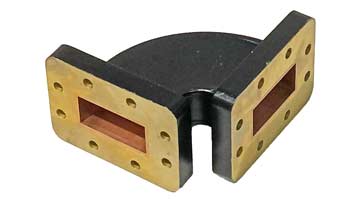Waveguide Cutoff Frequency
Waveguides have a minimum or cut-off frequency below which they are unable to operate.
Waveguide Tutorial Includes:
Waveguide basics
Waveguide modes
Waveguide impedance & matching
Waveguide cut-off-frequency
Waveguide flanges
Waveguide junctions
Waveguide bends
Flexible waveguide
Waveguide types & sizes
As a result of the way in which waveguides operate, all waveguides have a cut-off frequency. Below this cut-off frequency the waveguide is unable to support power transfer along its length.
When choosing a waveguide it is important to bear this frequency in mind, especially if any changes to the system may be likely.

In view of the critical nature of the cut-off frequency, it is one of the major specifications associated with any waveguide product.
Waveguide cut-off frequency background
Waveguides will only carry or propagate signals above a certain frequency, known as the cut-off frequency.
Below the waveguide cutoff frequency, it is not able to carry the signals.
In order to carry signals a waveguide needs to be able to propagate the signals and this is dependent upon the wavelength of the signal. If the wavelength is too long, then the waveguide will not operate in a mode whereby it can carry the signal.
As might be imagined, the cut-off frequency depends upon its dimensions. In view of the mechanical constraints this means that waveguides are only used for microwave frequencies.
Although it is theoretically possible to build waveguides for lower frequencies the size would not make them viable to contain within normal dimensions and their cost would be prohibitive.
As a very rough guide to the dimensions required for a waveguide, the width of a waveguide needs to be of the same order of magnitude as the wavelength of the signal being carried.
As a result, there is a number of standard sizes used for waveguides as detailed in another page of this tutorial. Also other forms of waveguide may be specifically designed to operate on a given band of frequencies
Waveguide cut-off frequency definition
In order to understand the cut-off frequency of a waveguide, it often helps to have a concise definition as a starting point.
Waveguide cut-ff frequency definition:
The cut-off frequency of a waveguide is the frequency that is taken to be the transition between the lower frequencies where signals cannot be propagated through the waveguide and the higher frequencies where they will propagate through it with minimal attenuation.
The cut-off frequency is relatively sharp and signals below the cut-off frequency will not propagate through.
Waveguide cut-off frequency details
Although the exact mechanics for the cut-off frequency of a waveguide vary according to whether it is rectangular, circular, etc, a good visualisation can be gained from the example of a rectangular waveguide. This is also the most widely used form.
Signals can progress along a waveguide using a number of modes. However the dominant mode is the one that has the lowest cut-off frequency. For a rectangular waveguide, this is the TE10 mode.
The TE means transverse electric and indicates that the electric field is transverse to the direction of propagation.

The diagram shows the electric field across the cross section of the waveguide. The lowest frequency that can be propagated by a mode equates to that were the wave can "fit into" the waveguide.
As seen by the diagram, it is possible for a number of modes to be active and this can cause significant problems and issues. All the modes propagate in slightly different ways and therefore if a number of modes are active, signal issues occur.
It is therefore best to select the waveguide dimensions so that, for a given input signal, only the energy of the dominant mode can be transmitted by the waveguide. For example: for a given frequency, the width of a rectangular guide may be too large: this would cause the TE20 mode to propagate.
As a result, for low aspect ratio rectangular waveguides the TE20 mode is the next higher order mode and it is harmonically related to the cut-off frequency of the TE10 mode. This relationship and attenuation and propagation characteristics that determine the normal operating frequency range of rectangular waveguide.
Rectangular waveguide cut-off frequency formula
Although waveguides can support many modes of transmission, the one that is used, virtually exclusively is the TE10 mode. If this assumption is made, then the calculation for the lower cut-off point becomes very simple. The cut-off frequency for a rectangular waveguide can be calculated using the formula given below:

Where:
fc = rectangular waveguide cut-off frequency in Hz
c = speed of light within the waveguide in metres per second
a = the larger internal dimension of the waveguide in metres
It is worth noting that the cut-off frequency is independent of the other dimension of the waveguide. This is because the major dimension governs the lowest frequency at which the waveguide can propagate a signal.
Circular waveguide cut-off frequency formula
Circular waveguides require a different forumla in view of the very different shape that they have.

A different formula is required to calculate the cut-off frequency of a circular waveguide.
Where:
fc = circular waveguide cut-off frequency in Hz
c = speed of light within the waveguide in metres per second
a = the internal radius for the circular waveguide in metres
Although it is possible to provide more generic waveguide cut-off frequency formulae, these ones are simple, easy to use and accommodate, by far the majority of calculations needed.
The cut-off frequency for a waveguide is one of the most important parameters. It sets a total limit on the lowest frequency that can be used by any frequency.
More Antenna & Propagation Topics:
EM waves
Radio propagation
Ionospheric propagation
Ground wave
Meteor scatter
Tropospheric propagation
Antenna basics
Cubical quad
Dipole
Discone
Ferrite rod
Log periodic antenna
Parabolic reflector antenna
Phased array antennas
Vertical antennas
Yagi
Antenna grounding
Installation guidelines
TV antennas
Coax cable
Waveguide
VSWR
Antenna baluns
MIMO
Return to Antennas & Propagation menu . . .



